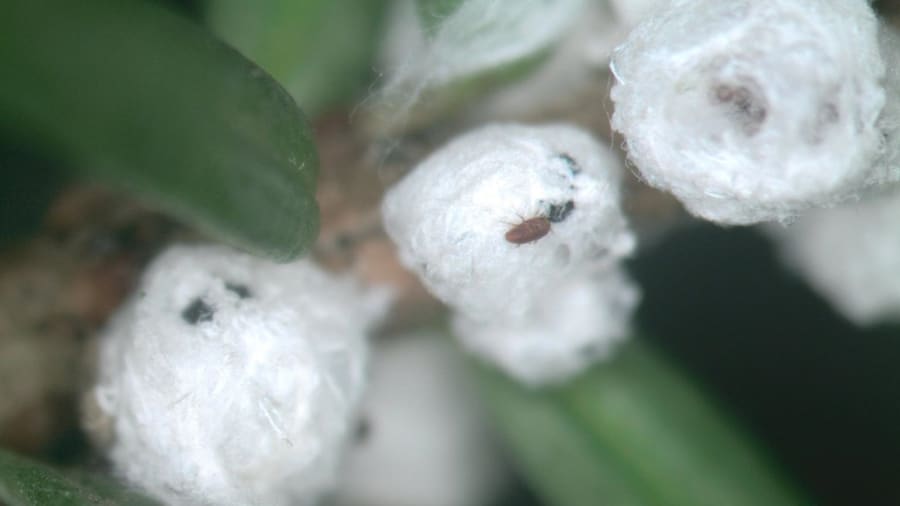MISSAUKEE COUNTY, Mich. – Invasive balsam woolly adelgid has been confirmed in Missaukee County.
Balsam woolly adelgid is a tiny, sap-feeding insect that attacks true fir trees, including balsam, Fraser and concolor (white) fir. Repeated attacks from the pest weaken trees, cause twig gouting, kill branches, and can cause the trees to die.
This is the second county in Michigan to have a confirmed infestation. The insect was first detected in 2021 in Rockford in Kent County.
“The infestation was found by a consulting forester who was working with the landowner. We don’t known how balsam woolly adelgid was introduced to this site, but early detection is a fundamental component of successful response efforts,” said Mike Philip, Director of MDARD’s Pesticide and Plant Pest Management Division. “MDARD and its partner agencies have begun survey work to determine the extent of the infestation.”
What you can do to help
Winter is the best time to look for evidence of an infestation. As the tiny, soft-bodied insects feed, they consume a hemlock’s stored nutrients and slowly suck the life from the tree.
“Cooler temperatures trigger feeding activity,” Robert Miller, MDARD’s invasive species prevention and response specialist said. “As hemlock woolly adelgids feed, they secrete a white, waxy material that creates ovisacs. The presence of these small, round, white masses makes it possible to identify infested trees.”
Hemlock trees can be protected with insecticide treatments. During the survey, infested trees and any other hemlocks within the area will be mapped and tagged for summer treatment.
If you have hemlocks on your property, you should take some time to check for signs of infestation. Hemlock trees are found in moist soils along streams and riverbanks and along coastal dunes. Hemlock also is popular as a landscape tree in parks and residential areas.
---> Meet Michigan’s 8 invasive insects: What they are, the damage they cause and what to do about them
How to identify a hemlock tree

The adelgids feed and form ovisacs only on eastern hemlock trees in Michigan, which is why it’s important to distinguish them from other conifers like pines or spruces.
The DNR suggests looking for the following:
- Cone- or egg-shaped trees up to 75 feet tall.
- Drooping or feathery branches.
- Flat needles growing individually from the sides of twigs.
- Needles that are dark green on top with two parallel, white stripes underneath.
- Papery cones about three-quarters of an inch long that hang downward from branches.
You should look on the undersides of branches for evidence of round, white ovisacs near the base of the needles. Up close, ovisacs look like tiny cotton balls and may appear alone or in clusters.
How to report infested hemlock trees
If you find an infested hemlock tree, you can report it by using the Midwest Invasive Species Information Network online by clicking here.
Symptoms of balsam woolly adelgid infestation include the following:
- Tiny one-to-two-millimeter white woolly tufts on the lower trunk of the tree and possibly on large branches in the spring and summer.
- Swelling and distortion of the twigs, commonly called “gout.”
- Flagging – A branch or branches that turn brick-red and die.
- Tree crowns that become narrow and misshapen with few needles.
Reports also can be made by email to MDA-Info@Michigan.gov or by phone to MDARD’s Customer Service Center at 800-292-3939.
Share the location of the infested trees and try to take one or two pictures of infested branches to help confirm identification. To avoid spreading hemlock woolly adelgid, do not collect sample branches or twigs.

How hemlock trees can be treated
There are certain insecticides that can successfully treat the infestation if used correctly.
Without treatment, infested trees can die within four to 10 years. A qualified arborist can diagnose and assist with treating infested trees.
If you are able to handle treatment on your own, the DNR recommends following guidance from the MSU Extension bulletin here.
Even if you plan to handle treatment on your own, you should still report the infestation so officials can track where hemlock woolly adelgid has spread.




